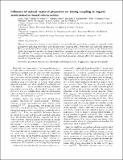Files in this item
Influence of optical material properties on strong coupling in organic semiconductor based microcavities
Item metadata
| dc.contributor.author | Tropf, Laura Christine | |
| dc.contributor.author | Dietrich, Christof Peter | |
| dc.contributor.author | Herbst, Stefanie | |
| dc.contributor.author | Kanibolotsky, Alexander L. | |
| dc.contributor.author | Skabara, Peter J. | |
| dc.contributor.author | Würthner, Frank | |
| dc.contributor.author | Samuel, Ifor D. W. | |
| dc.contributor.author | Gather, Malte C. | |
| dc.contributor.author | Höfling, Sven | |
| dc.date.accessioned | 2017-03-03T15:30:10Z | |
| dc.date.available | 2017-03-03T15:30:10Z | |
| dc.date.issued | 2017-04 | |
| dc.identifier | 249289260 | |
| dc.identifier | 753ddb35-0472-4119-8fa3-d634729c8a11 | |
| dc.identifier | 85017646901 | |
| dc.identifier | 000399689400031 | |
| dc.identifier.citation | Tropf , L C , Dietrich , C P , Herbst , S , Kanibolotsky , A L , Skabara , P J , Würthner , F , Samuel , I D W , Gather , M C & Höfling , S 2017 , ' Influence of optical material properties on strong coupling in organic semiconductor based microcavities ' , Applied Physics Letters , vol. 110 , no. 15 , 153302 . https://doi.org/10.1063/1.4978646 | en |
| dc.identifier.issn | 0003-6951 | |
| dc.identifier.other | ORCID: /0000-0002-4857-5562/work/47136499 | |
| dc.identifier.uri | https://hdl.handle.net/10023/10399 | |
| dc.description | We acknowledge financial support from the European Research Council (ERC StG 640012), the Scottish Funding Council (through SUPA), the studentship funding through the EPSRC CM-CDT (EP/L015110/1) and the EPSRC Hybrid Polaritonics program grant (EP/M025330/1). I. D. W. Samuel and P. J. Skabara each acknowledge support from a Royal Society Wolfson Research Merit Award. A. L. Kanibolotsky thanks the EPSRC for funding (EP/I029141). | en |
| dc.description.abstract | The optical properties of organic semiconductors are generally characterised by a number of material specific parameters, including absorbance, photoluminescence quantum yield, Stokes shift and molecular orientation. Here, we study four different organic semiconductors and compare their optical properties to the characteristics of the exciton-polaritons that are formed when these materials are introduced into metal-clad microcavities. We find that the strength of coupling between cavity photons and excitons is clearly correlated with the absorptivity of the material. In addition, we show that anisotropy strongly affects the characteristics of the formed exciton-polaritons. | |
| dc.format.extent | 5 | |
| dc.format.extent | 1479574 | |
| dc.language.iso | eng | |
| dc.relation.ispartof | Applied Physics Letters | en |
| dc.subject | Polaritons | en |
| dc.subject | Fluorescence | en |
| dc.subject | Anisotropy | en |
| dc.subject | Material properties | en |
| dc.subject | J-aggregates | en |
| dc.subject | Conjugated polymers | en |
| dc.subject | QC Physics | en |
| dc.subject | DAS | en |
| dc.subject | MCP | en |
| dc.subject.lcc | QC | en |
| dc.title | Influence of optical material properties on strong coupling in organic semiconductor based microcavities | en |
| dc.type | Journal article | en |
| dc.contributor.sponsor | European Research Council | en |
| dc.contributor.sponsor | EPSRC | en |
| dc.contributor.sponsor | EPSRC | en |
| dc.contributor.institution | University of St Andrews. School of Physics and Astronomy | en |
| dc.contributor.institution | University of St Andrews. Organic Semiconductor Centre | en |
| dc.contributor.institution | University of St Andrews. Condensed Matter Physics | en |
| dc.contributor.institution | University of St Andrews. Biomedical Sciences Research Complex | en |
| dc.identifier.doi | 10.1063/1.4978646 | |
| dc.description.status | Peer reviewed | en |
| dc.identifier.grantnumber | 640012 | en |
| dc.identifier.grantnumber | EP/L015110/1 | en |
| dc.identifier.grantnumber | EP/M025330/1 | en |
This item appears in the following Collection(s)
Items in the St Andrews Research Repository are protected by copyright, with all rights reserved, unless otherwise indicated.

